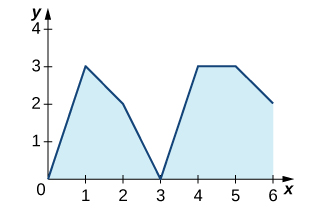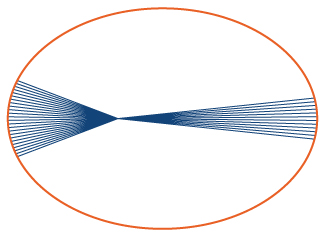1.3E: Exercises for Section 1.3
- Last updated
- Sep 9, 2021
- Save as PDF
- Page ID
- 83594
( \newcommand{\kernel}{\mathrm{null}\,}\)
1) Consider two athletes running at variable speeds
2) Two mountain climbers start their climb at base camp, taking two different routes, one steeper than the other, and arrive at the peak at exactly the same time. Is it necessarily true that, at some point, both climbers increased in altitude at the same rate?
- Answer
- Yes. It is implied by the Mean Value Theorem for Integrals.
3) To get on a certain toll road a driver has to take a card that lists the mile entrance point. The card also has a timestamp. When going to pay the toll at the exit, the driver is surprised to receive a speeding ticket along with the toll. Explain how this can happen.
4) Set
- Answer
over is
In exercises 5 - 16, use the Fundamental Theorem of Calculus, Part 1, to find each derivative.
5)
6)
- Answer
7)
8)
- Answer
9)
10)
- Answer
11)
12)
- Answer
13)
14)
- Answer
15)
16)
- Answer
17) The graph of

a. Over which intervals is
b. What are the maximum and minimum values of
c. What is the average value of
18) The graph of
![A graph of a function with linear segments that goes through the points (0, 0), (1, -1), (2, 1), (3, 1), (4, -2), (5, -2), and (6, 0). The area over the function but under the x axis over the interval [0, 1.5] and [3.25, 6] is shaded. The area under the function but over the x axis over the interval [1.5, 3.25] is shaded.](https://math.libretexts.org/@api/deki/files/2611/CNX_Calc_Figure_05_03_203.jpeg?revision=1&size=bestfit&width=325&height=208)
a. Over which intervals is
b. What are the maximum and minimum values of
c. What is the average value of
- Answer
- a.
is positive over and , negative over and , and zero over and .
b. The maximum value isand the minimum is .
c. The average value is.
19) The graph of
![A graph of a function which goes through the points (0, 0), (1, -1), (2, 1), (3, 3), (4, 3.5), (5, 4), and (6, 2). The area over the function and under the x axis over [0, 1.8] is shaded, and the area under the function and over the x axis is shaded.](https://math.libretexts.org/@api/deki/files/2612/CNX_Calc_Figure_05_03_204.jpeg?revision=1&size=bestfit&width=325&height=246)
a. Over which intervals is
b. Over which intervals is
c. What is the average value of
20) The graph of
![A graph of a function that goes through the points (0, 0), (1, 1), (2, 0), (3, -1), (4.5, 0), (5, 1), and (6, 2). The area under the function and over the x axis over the intervals [0, 2] and [4.5, 6] is shaded. The area over the function and under the x axis over the interval [2, 2.5] is shaded.](https://math.libretexts.org/@api/deki/files/2613/CNX_Calc_Figure_05_03_205.jpeg?revision=1&size=bestfit&width=325&height=208)
a. Over which intervals is
b. Over which intervals is
c. What is the average value of
- Answer
- a.
is positive over and , and negative over .
b. It is increasing overand , and it is constant over and .
c. Its average value is.
In exercises 21 - 26, use a calculator to estimate the area under the curve by computing
21) [T]
22) [T]
- Answer
23) [T]
24) [T]
- Answer
25) [T]
26) [T]
- Answer
In exercises 27 - 46, evaluate each definite integral using the Fundamental Theorem of Calculus, Part 2.
27)
28)
- Answer
29)
30)
- Answer
31)
32)
- Answer
33)
34)
- Answer
35)
36)
- Answer
37)
38)
- Answer
39)
40)
- Answer
41)
42)
- Answer
43)
44)
- Answer
45)
46)
- Answer
In exercises 47 - 50, use the evaluation theorem to express the integral as a function
47)
48)
- Answer
49)
50)
- Answer
In exercises 51 - 54, identify the roots of the integrand to remove absolute values, then evaluate using the Fundamental Theorem of Calculus, Part 2.
51)
52)
- Answer
53)
54)
- Answer
55) Suppose that the number of hours of daylight on a given day in Seattle is modeled by the function
a. What is the average number of daylight hours in a year?
b. At which times
c. Write an integral that expresses the total number of daylight hours in Seattle between
d. Compute the mean hours of daylight in Seattle between
56) Suppose the rate of gasoline consumption in the United States can be modeled by a sinusoidal function of the form
a. What is the average monthly consumption, and for which values of
b. What is the number of gallons of gasoline consumed in the United States in a year?
c. Write an integral that expresses the average monthly U.S. gas consumption during the part of the year between the beginning of April
- Answer
- a. The average is
has period 12 and integral 0 over any period. Consumption is equal to the average when
b. Total consumption is the average rate times duration:
c.
57) Explain why, if
58) Explain why, if
- Answer
- If
is not constant, then its average is strictly smaller than the maximum and larger than the minimum, which are attained over by the extreme value theorem.
59) Kepler’s first law states that the planets move in elliptical orbits with the Sun at one focus. The closest point of a planetary orbit to the Sun is called the perihelion (for Earth, it currently occurs around January 3) and the farthest point is called the aphelion (for Earth, it currently occurs around July 4). Kepler’s second law states that planets sweep out equal areas of their elliptical orbits in equal times. Thus, the two arcs indicated in the following figure are swept out in equal times. At what time of year is Earth moving fastest in its orbit? When is it moving slowest? Kepler’s first law states that the planets move in elliptical orbits with the Sun at one focus. The closest point of a planetary orbit to the Sun is called the perihelion (for Earth, it currently occurs around January 3) and the farthest point is called the aphelion (for Earth, it currently occurs around July 4). Kepler’s second law states that planets sweep out equal areas of their elliptical orbits in equal times. Thus, the two arcs indicated in the following figure are swept out in equal times. At what time of year is Earth moving fastest in its orbit? When is it moving slowest?

60) A point on an ellipse with major axis length
a. Show that the distance from this point to the focus at
Use these coordinates to show that the average distance
- Answer
- a.
b.
61) As implied earlier, according to Kepler’s laws, Earth’s orbit is an ellipse with the Sun at one focus. The perihelion for Earth’s orbit around the Sun is 147,098,290 km and the aphelion is 152,098,232 km.
a. By placing the major axis along the
b. The classic definition of an astronomical unit (AU) is the distance from Earth to the Sun, and its value was computed as the average of the perihelion and aphelion distances. Is this definition justified?
62) The force of gravitational attraction between the Sun and a planet is
- Answer
- Mean gravitational force
The displacement from rest of a mass attached to a spring satisfies the simple harmonic motion equationis a phase constant, is the angular frequency, and is the amplitude. Find the average velocity, the average speed (magnitude of velocity), the average displacement, and the average distance from rest (magnitude of displacement) of the mass.

